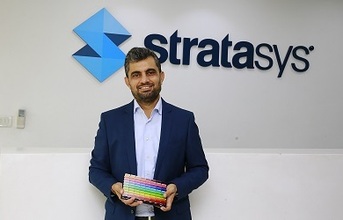
How do you see additive manufacturing impacting the evolution of the industry going beyond just prototyping?
Yes, prototyping is an easy application. You have a part that you want to replicate and see how it will look good and fit into some assembly. That's basically how prototyping works with 3D printing.
But there are certain challenges that people want to solve with 3D printing. Let's say you want to make some specific jigs and fixtures for the line, or you want to add on some specific features to an existing part. Those are the areas where designers try and experiment. It's like a doodle in their hands. So, they add features in the software, quickly 3D print, check, evaluate, go back and continually improve the process.
What we understand from auto companies is that it gives them more iterations in a much lesser time. This gives them a better product in a much lesser amount of time than they would initially require.
Then, people are innovating to the extent that they are taking it to the shopfloor. They are also taking it to the quality department and they are even looking at aspects like employee health and safety. So, 3D printing has become integral to the entire workflow and not just to the prototyping of parts.
Do you think additive manufacturing can empower start-ups?
Definitely. For example, if a start-up has to translate a design into a product line and if it has to go the traditional ways, then it is going to require many tools just to come up with the first few parts. This includes long lead times and a lot of expenses. They will have to give it at least a few weeks to happen. Whereas with 3D printing, you can print it in a few hours, evaluate, check, and show it to your investors or show it to the people who have developed this product and you are done.
That's the kind of differentiation 3D printing brings to start-ups. People who do not have a full-fledged manufacturing setup at their beck and call like big companies have, they see it as a big advantage. They indeed have an inherent advantage of the process because there's zero investment in toolings. You just go and manufacture what you want. As simple as that!
Do you think additive manufacturing will grow, if there is more skill development and more training happening?
In the journey of 3D printing, people discovered much later that design for additive manufacturing also plays a very big role. So, you have a better tool to design and you have a machine that has no constraints of the traditional processes. We firmly believe that engineers at an early learning stage itself know about the power of 3D printing, along with the constraints of manufacturing.
We are not saying 3D printing will kill traditional manufacturing or traditional manufacturing will survive long enough not to let 3D printing develop. Most intelligent and successful organisations will use both of them together in tandem and complement each other. So, with that being said, it becomes very important for the students who are coming out of the universities to know more about design for additive manufacturing because they are at a stage where they're experimenting with software. Software play a big role in design for additive manufacturing. And once they are out of the institute or university and go into the industry they are able to utilise it more effectively compared to the existing set of people who are tuned into the old way of manufacturing for a very long time. Design for additive manufacturing is going to become very big alongside of additive manufacturing.
How interoperable are Stratasys software and machines with other design software?
Our machines work with all design software. GrabCAD is a new addition to our portfolio although it's not new and has been with us for a while. GrabCAD is more of a printing management and optimization software. There are CAD functionalities that are being added to it. We also have a huge portal which has collection of 3D printed parts that you can download and print; people contribute freely over there. So yes, these are definitive steps. If we have a vision of making our 3D printers part of industry portfolio, then there has to be traceability, repeatability and so on, and Grab CAD will also play a key role in that in connecting it with the enterprise.
END
